Hao-Chun Yang
Self-Supervised Masked Mesh Learning for Unsupervised Anomaly Detection on 3D Cortical Surfaces
Dec 07, 2024


Abstract:Unsupervised anomaly detection in brain imaging is challenging. In this paper, we propose a self-supervised masked mesh learning for unsupervised anomaly detection in 3D cortical surfaces. Our framework leverages the intrinsic geometry of the cortical surface to learn a self-supervised representation that captures the underlying structure of the brain. We introduce a masked mesh convolutional neural network (MMN) that learns to predict masked regions of the cortical surface. By training the MMN on a large dataset of healthy subjects, we learn a representation that captures the normal variation in the cortical surface. We then use this representation to detect anomalies in unseen individuals by calculating anomaly scores based on the reconstruction error of the MMN. We evaluate our framework by training on population-scale dataset UKB and HCP-Aging and testing on two datasets of Alzheimer's disease patients ADNI and OASIS3. Our results show that our framework can detect anomalies in cortical thickness, cortical volume, and cortical sulcus features, which are known to be sensitive biomarkers for Alzheimer's disease. Our proposed framework provides a promising approach for unsupervised anomaly detection based on normative variation of cortical features.
Learning Cortical Anomaly through Masked Encoding for Unsupervised Heterogeneity Mapping
Dec 11, 2023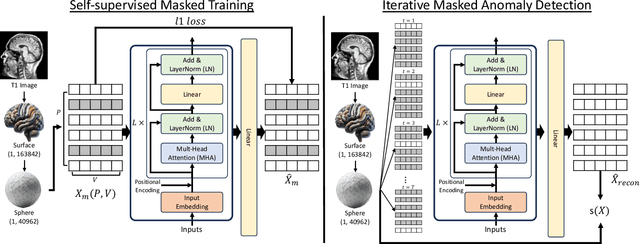
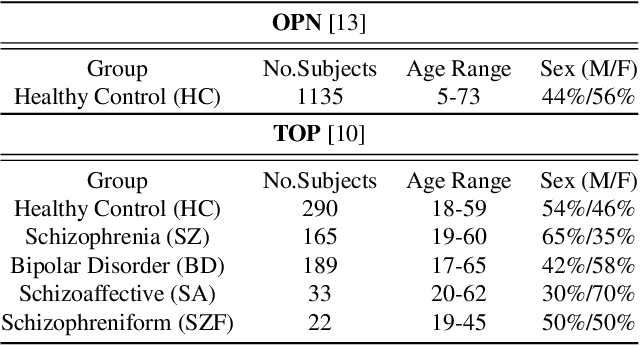


Abstract:The detection of heterogeneous mental disorders based on brain readouts remains challenging due to the complexity of symptoms and the absence of reliable biomarkers. This paper introduces CAM (Cortical Anomaly Detection through Masked Image Modeling), a novel self-supervised framework designed for the unsupervised detection of complex brain disorders using cortical surface features. We employ this framework for the detection of individuals on the psychotic spectrum and demonstrate its capabilities compared to state-ofthe-art methods, achieving an AUC of 0.696 for Schizoaffective and 0.769 for Schizophreniform, without the need for any labels. Furthermore, the analysis of atypical cortical regions includes Pars Triangularis and several frontal areas, often implicated in schizophrenia, provide further confidence in our approach. Altogether, we demonstrate a scalable approach for anomaly detection of complex brain disorders based on cortical abnormalities.
Behavior Score-Embedded Brain Encoder Network for Improved Classification of Alzheimer Disease Using Resting State fMRI
Nov 04, 2022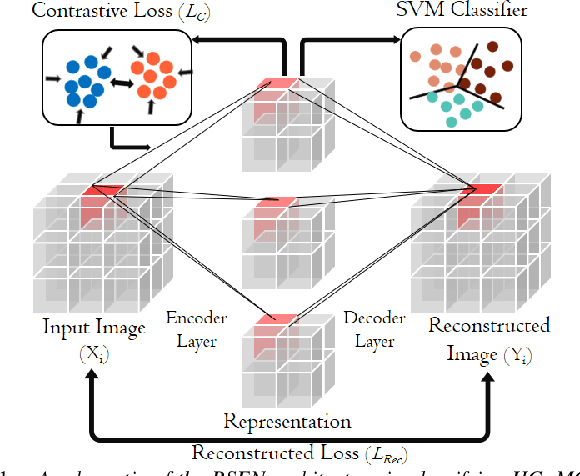


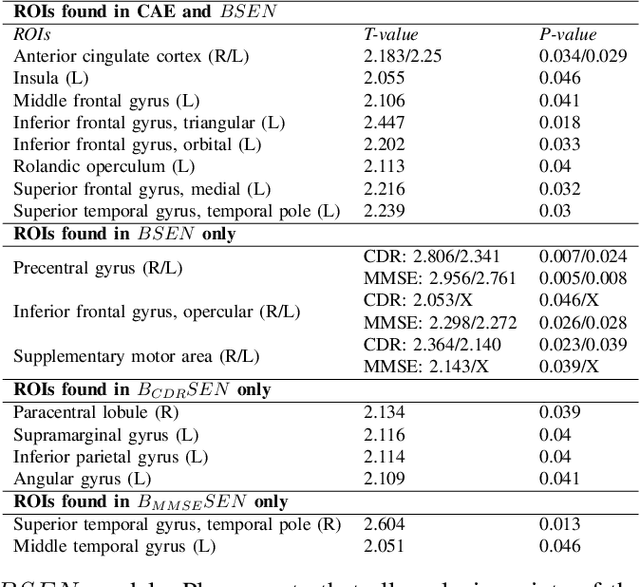
Abstract:The ability to accurately detect onset of dementia is important in the treatment of the disease. Clinically, the diagnosis of Alzheimer Disease (AD) and Mild Cognitive Impairment (MCI) patients are based on an integrated assessment of psychological tests and brain imaging such as positron emission tomography (PET) and anatomical magnetic resonance imaging (MRI). In this work using two different datasets, we propose a behavior score-embedded encoder network (BSEN) that integrates regularly adminstrated psychological tests information into the encoding procedure of representing subject's restingstate fMRI data for automatic classification tasks. BSEN is based on a 3D convolutional autoencoder structure with contrastive loss jointly optimized using behavior scores from MiniMental State Examination (MMSE) and Clinical Dementia Rating (CDR). Our proposed classification framework of using BSEN achieved an overall recognition accuracy of 59.44% (3-class classification: AD, MCI and Healthy Control), and we further extracted the most discriminative regions between healthy control (HC) and AD patients.
A Mixed-Domain Self-Attention Network for Multilabel Cardiac Irregularity Classification Using Reduced-Lead Electrocardiogram
Apr 29, 2022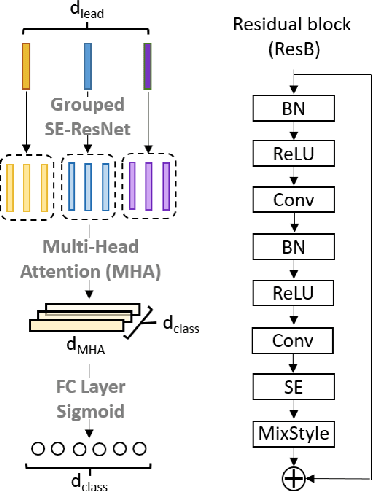
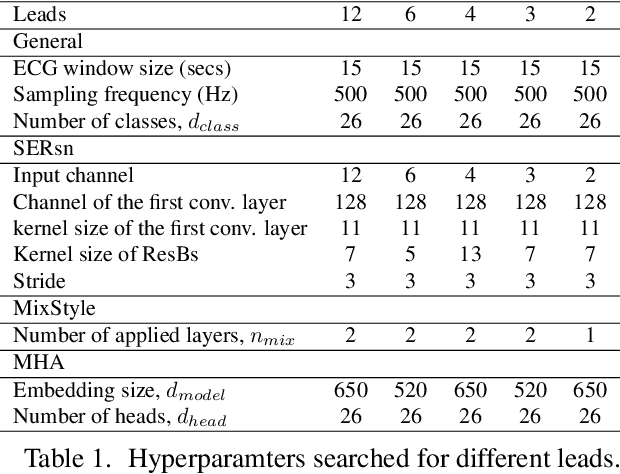
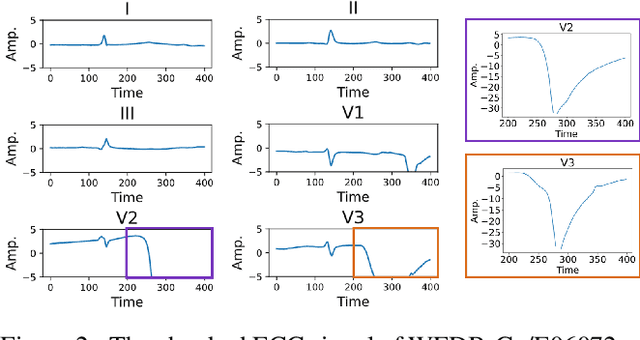
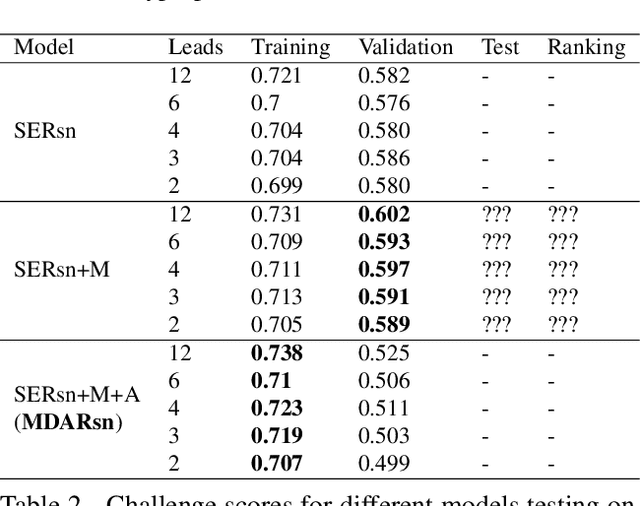
Abstract:Electrocardiogram(ECG) is commonly used to detect cardiac irregularities such as atrial fibrillation, bradycardia, and other irregular complexes. While previous studies have achieved great accomplishment classifying these irregularities with standard 12-lead ECGs, there existed limited evidence demonstrating the utility of reduced-lead ECGs in capturing a wide-range of diagnostic information. In addition, classification model's generalizability across multiple recording sources also remained uncovered. As part of the PhysioNet Computing in Cardiology Challenge 2021, our team HaoWan AIeC, proposed Mixed-Domain Self-Attention Resnet (MDARsn) to identify cardiac abnormalities from reduced-lead ECG. Our classifiers received scores of 0.602, 0.593, 0.597, 0.591, and 0.589 (ranked 54th, 37th, 38th, 38th, and 39th) for the 12-lead, 6-lead, 4-lead, 3-lead, and 2-lead versions of the hidden validation set with the evaluation metric defined by the challenge.
 Add to Chrome
Add to Chrome Add to Firefox
Add to Firefox Add to Edge
Add to Edge